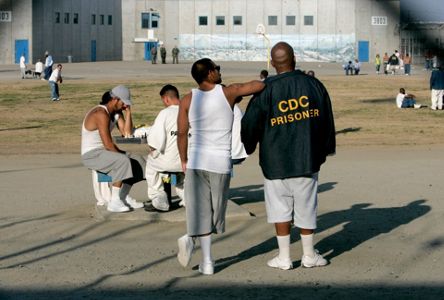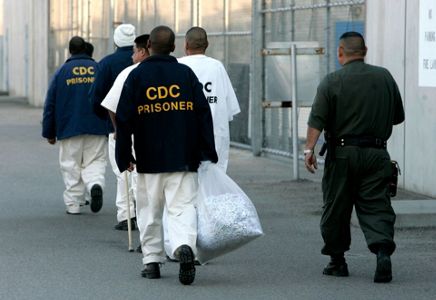SACRAMENTO, Calif. (AP) — California prison officials have halted an effort aimed at forcing warring prison gangs to get along with each other after the inmates wound up brawling and even rioting when placed together in prison recreation yards, officials told The Associated Press.
The effort started a year ago with officials gradually allowing prisoners from different gangs into exercise yards to try to get them to make peace. This permitted officials to reduce harsh restrictions that kept gang members locked up in cells for lengthy periods without access to rehabilitation programs that could allow them to shorten their sentences.
But the greater liberty generated the same result at several state prisons: Gang members brawled in what critics labeled "gladiator fights" that they allege prison officials deliberately set up to get the inmates to fight.
The brawls led officials to stop the practice of trying to get the gang inmates to interact with each other in the prisons, Shaun Spillane, a spokesman for the corrections department's inspector general, told the AP in an interview.
Prison officials "are kind of at the point where they realize this isn't working. Rather than getting the same result, they're putting their heads together and trying to come up with a new approach," Spillane said.
The program is on hold so officials "can explore options to find a resolution to this and safely house these individuals," said Terry Thornton, spokeswoman for the corrections department.
She denied that officials set up inmates up to fight.
"I don't know why they fight. We just expect our people to engage in positive behavior, engage in positive programs," she said.
At the heart of the problem is the Fresno Bulldogs prison gang that has participated in 32 battles with other prison gangs over the last year, ranging from small fights to full-scale riots, according to data prepared for the AP by the inspector general's office.
The Fresno Bulldogs, a street gang with more than 6,000 loosely affiliated members in the city of Fresno, engages in human trafficking, drug drug dealing, robbery and other crimes, said Lt. Steve Card of the Fresno police gang task force. They took the name and mascot of California State University, Fresno, and wear the college's trademark red clothing. Members are loosely affiliated on the streets but their membership solidifies in prison, Card said.
"In the prison system the Bulldogs do not get along with anybody," he said.
California prison officials tried 45 times to put gang members in the same yards with other inmates, with violence erupting 27 times, the data from the inspector general's office showed. The inmates also rioted three times last fall before prison officials began trying to get them to co-exist.
"Every threat group is having issues with the Bulldogs, or vice versa. These are all Bulldogs vs. other threat groups," Spillane said.
Early attempts by prison officials involved a few inmates each from the Bulldogs and competing gangs, but the fights recently escalated into full-scale riots.
The most recent brawl happened Aug. 14 at the Correctional Training Facility in Soledad, south of San Francisco, when 200 inmates rioted. Eight inmates were treated at outside hospitals for puncture wounds, cuts and bruises and 50 inmates were treated by prison medical staff for what officials described as minor injuries.
"That was part of their efforts to see if the two gangs could co-exist," Spillane said.
Officials were forced to fire nine warning shots to break up the fight and they also used pepper spray and other non-lethal weapons. Members of one of the two gangs refused to obey orders to lie down on the ground until guards from other housing units at the prison and another prison arrived.
In July, there were two riots in July at Pleasant Valley State Prison in California's Central Valley agricultural heartland, the most recent one involving 182 inmates. Three inmates were treated at outside hospitals for puncture wounds after guards using pepper spray broke it up.
Prisoner advocate Richard Edmond-Vargas, who co-founded the criminal justice reform group Initiate Justice three years ago while serving prison time for robbery, blamed corrections officials for putting the gangs in situations where brawls were inevitable.
"They actively put folks in this situation where they would have to fight and they know the culture of prison is that you have to fight," Edmond-Vargas said.
But he said the change in tactics from a previous policy in which rival gang members were kept separate is disrupting prison life and affecting those caught up in the violence against their will or who can't participate in rehabilitation programs that could shorten their sentences.
"The fact of the matter is they do have a conflict on their hands," Edmond-Vargas said. "What's that mean, they're going to keep half the prison population on lockdown forever?"
Problems began a year ago at Corcoran State Prison in the Central Valley when prison officials tried to introduce five members of the Bulldogs and six members of another gang to one another in a prison recreation yard. They immediately began fighting.
"Bulldogs basically have an attack-on-sight ethos," said prisoner rights attorney Charles Carbone, who is representing an inmate injured in a Nov. 30, 2018 brawl at Pleasant Valley State Prison.
Officials tried to force "peace talks" between five Bulldogs and five members of another gang, separating them with a fence but without keeping them handcuffed, Carbone said.
"When the talks immediately fell apart, inmates started attacking each other" after they were allowed back through the fence and ordered to return to their cells, he said.
Carbone said his client, an alleged member of the Surenos gang, was hit in the head as guards broke up the brawl and suffered facial injuries that left him with permanently impaired vision and cognitive issues.
"He's having problems with thinking clearly and memory and those sorts of things," Carbone said of his client, serving a 10-year sentence for robbery. "The judge never sentenced them to permanent injuries and irreparable harm."
Officials have tried intermittently ever since to integrate the gangs and invited the inspector general's staff to observe most attempts since April.
They had some success reintroducing smaller groups, Spillane said, including several uneventful attempts at the prison in Soledad in the weeks before the August riot.
Spillane said the inspector general's office has fielded numerous complaints, including from state lawmakers who represent the problem prisons, and plans to issue a report in coming months.
___
Associated Press writer Juliet Williams in San Francisco contributed to this report.
Copyright 2019 The Associated Press. All rights reserved. This material may not be published, broadcast, rewritten or redistributed.





